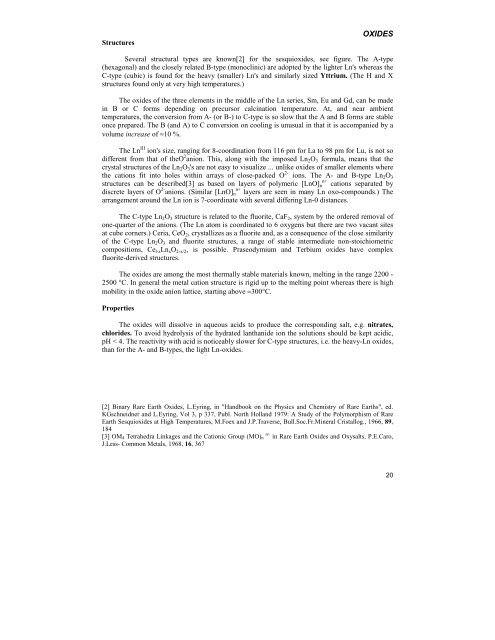A LANTHANIDE LANTHOLOGY (.pdf) - Davidson Physics
A LANTHANIDE LANTHOLOGY (.pdf) - Davidson Physics
A LANTHANIDE LANTHOLOGY (.pdf) - Davidson Physics
You also want an ePaper? Increase the reach of your titles
YUMPU automatically turns print PDFs into web optimized ePapers that Google loves.
StructuresOXIDESSeveral structural types are known[2] for the sesquioxides, see figure. The A-type(hexagonal) and the closely related B-type (monoclinic) are adopted by the lighter Ln's whereas theC-type (cubic) is found for the heavy (smaller) Ln's and similarly sized Yttrium. (The H and Xstructures found only at very high temperatures.)The oxides of the three elements in the middle of the Ln series, Sm, Eu and Gd, can be madein B or C forms depending on precursor calcination temperature. At, and near ambienttemperatures, the conversion from A- (or B-) to C-type is so slow that the A and B forms are stableonce prepared. The B (and A) to C conversion on cooling is unusual in that it is accompanied by avolume increase of ≈10 %.The Ln III ion's size, ranging for 8-coordination from 116 pm for La to 98 pm for Lu, is not sodifferent from that of theO 2 anion. This, along with the imposed Ln 2 O 3 formula, means that thecrystal structures of the Ln 2 O 3 's are not easy to visualize ... unlike oxides of smaller elements wherethe cations fit into holes within arrays of close-packed O 2- ions. The A- and B-type Ln 2 O 3structures can be described[3] as based on layers of polymeric [LnO] n n+ cations separated bydiscrete layers of O 2- anions. (Similar [LnO] n n+ layers are seen in many Ln oxo-compounds.) Thearrangement around the Ln ion is 7-coordinate with several differing Ln-0 distances.The C-type Ln 2 O 3 structure is related to the fluorite, CaF 2 , system by the ordered removal ofone-quarter of the anions. (The Ln atom is coordinated to 6 oxygens but there are two vacant sitesat cube corners.) Ceria, CeO 2 , crystallizes as a fluorite and, as a consequence of the close similarityof the C-type Ln 2 O 3 and fluorite structures, a range of stable intermediate non-stoichiometriccompositions, Ce l-x Ln x O 2-x/2 , is possible. Praseodymium and Terbium oxides have complexfluorite-derived structures.The oxides are among the most thermally stable materials known, melting in the range 2200 -2500 °C. In general the metal cation structure is rigid up to the melting point whereas there is highmobility in the oxide anion lattice, starting above ≈300°C.PropertiesThe oxides will dissolve in aqueous acids to produce the corresponding salt, e.g. nitrates,chlorides. To avoid hydrolysis of the hydrated lanthanide ion the solutions should be kept acidic,pH < 4. The reactivity with acid is noticeably slower for C-type structures, i.e. the heavy-Ln oxides,than for the A- and B-types, the light Ln-oxides.[2] Binary Rare Earth Oxides, L.Eyring, in "Handbook on the <strong>Physics</strong> and Chemistry of Rare Earths", ed.KGschneidner and L.Eyring, Vol 3, p 337, Publ. North Holland 1979: A Study of the Polymorphism of RareEarth Sesquioxides at High Temperatures, M.Foex and J.P.Traverse, Bull.Soc.Fr.Mineral Cristallog., 1966, 89,184[3] OM 4 Tetrahedra Linkages and the Cationic Group (MO) n n+ in Rare Earth Oxides and Oxysalts, P.E.Caro,J.Less- Common Metals, 1968, 16, 36720
















